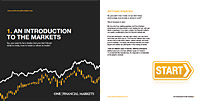

THE TRADE WAR AND VOLATILITY — ALL YOU SHOULD KNOW
6th August 2019
The trade dispute between the US and China continues to head down the path of a full-blown trade war. Market participants have been riding a roller coaster of sentiment which has been changing with each twist and turn. The trade dispute has played out in real-time thanks to social media and President Trump’s fondness for Twitter.
When did the trade war start?
Trade disputes between the US and China have been around for decades as China has rapidly grown and become the second largest global economy. One of the issues with emerging growth is the inability of the leaders to trade off reduced growth to become a larger player on the global trade market. China has been unwilling to completely change its trade policies, especially as they pertain to intellectual property.
The underlying source of the US/China stalemate
The US views Chinese trade practices as illegal and immoral. The US claims Chinese laws undermine intellectual property rights by forcing foreign companies to share their intellectual property with Chinese companies via joint venture arrangements. This allows Chinese partners to use, copy, or improve these technologies without having to pay for them. This process erodes the investment dollars needed to create the intellectual property in exchange for having access to China’s 1.2-billion people.
Trump sees China as a threat
Trump sees China as a threat and views its technical industrial plan of “Made in China 2025” as a threat to the US economy and national security.
Since January 22, 2018, China and the United States have been engaged in a trade dispute which has played out as a mutual placement of tariffs. In his campaign, US President Donald Trump declared that he would fix China’s abuse of the broken international system. In February of 2018, Trump ordered the implementation of global safeguard tariffs, which places a 30% tariff on solar panel imports. Three months later, the United States filed a request for consultation to the World Trade Organization regarding concerns that China was violating intellectual property rights.
During the past 16 months, the trade war has captured headlines. There were several cases where market participants believed that a deal was imminent. In early May of 2019, the market was pricing in a deal, pushing the S&P 500 and the Nasdaq to all-time highs. It all came apart again with a President Of The United States (POTUS) tweet which alerted the markets that the Chinese were backing down on their word.
What appears to have occurred was a misunderstanding of the impendency of a deal. The Chinese are nowhere near changing their stance on policing intellectual properties concerns. They also do not want a deal with the US to dictate how they will trade with the rest of the world. If an unfavourable deal with the US is consummated, a European and Japanese deal with China will not be far behind.
China also has time on its side. President Xi has no elections in store for the country, while President Trump will need to go to the polls again in November of 2020. Trump also believes that the Chinese want to run out the clock, and to dissuade them from doing this, he is willing to up the stakes.
How trade wards influence market volatility
Market volatility becomes more pronounced during a trade war, as both the US and the Chinese economies will continue to face headwinds and certain sectors are haemorrhaging. Grain commodity prices in the US have tumbled and will likely never returns to prior levels. The Chinese have likely found other suppliers who will permanently take their place in the supply chain.
While Chinese imports on US goods such as agriculture has generated pain for farmers, the costs of electronics for US customers are rising. While President Trump is quick to tell customers they should buy American products, the US customer is more focused on price.
When will the volatility subside?
It is hard to pinpoint a specific time when trade-related volatility will subside. President Trump believes tariffs are the best tool to use to get your way. Even if a deal with China is completed, the next counterparts for the US to tackle are Europe and Japan. This will likely keep volatility elevated for the foreseeable future. If a deal is completed between the US and China where both sides can praise the outcome, then equity markets will rally and volatility will decline, in the short run.
Conclusion
In summary, the trade war between the US and China is more about the future than the past. China believes that to gain access to their population, there is a price. President Trump believes he can use tariffs to get his way. As headlines continue to describe any progress between the US and China, markets will continue to whipsaw generating additional market volatility.
Begin trading today! Create an account by completing our form
Privacy Notice
At One Financial Markets we are committed to safeguarding your privacy.
Please see our Privacy Policy for details about what information is collected from you and why it is collected. We do not sell your information or use it other than as described in the Policy.
Please note that it is in our legitimate business interest to send you certain marketing emails from time to time. However, if you would prefer not to receive these you can opt-out by ticking the box below.
Alternatively, you can use the unsubscribe link at the bottom of the Demo account confirmation email or any subsequent emails we send.
By completing the form and downloading the platform you agree with the use of your personal information as detailed in the Policy.






